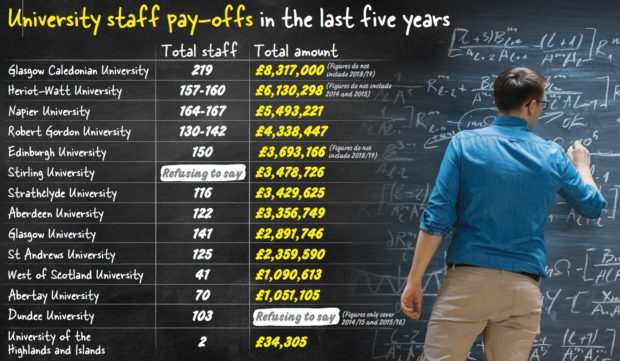Universities in Scotland have racked up a bill of almost £50million by paying off more than 1,550 staff in the last few years, it can be revealed.
Figures released to The Press and Journal show that the two Aberdeen-based universities accounted for £7.7million of the spending on severance packages and settlement agreements.
Aberdeen University and Robert Gordon University (RGU) spent the money on the departures of more than 250 staff in the last five years.
RGU had the fourth highest overall bill in Scotland, including its controversial £237,000 “golden goodbye” for former principal Ferdinand von Prondzynski last year.
>> Keep up to date with the latest news with The P&J newsletter
The row over his departure prompted a review to tighten-up governance rules across Scotland, including a recommendation that universities should publish details on termination payments for senior staff “as soon as possible” after they are agreed.
The vast majority of RGU’s £4.3million spending went on voluntary severance packages for 126 staff in 2015/16, however, while Aberdeen University spent more than £2million in the same year as 71 employees left.
Across Scotland, universities provided details of £45.66million of spending on staff exits in five years, but the true figure is believed to be millions of pounds higher, because Dundee University refused to reveal its bill, and three others only released partial data.
Glasgow Caledonian University had the highest bill, spending £8.3million on the departure of 219 staff, while the lowest spender was the University of the Highlands and Islands, where just £34,305 was paid to two employees in five years.
Mary Senior, University and College Union Scotland official, said: “With rising workloads and increasing student-staff ratios the last thing our universities need is to be losing staff.
“Where people do lose their jobs it’s important that they receive a fair redundancy payment that allows them to move on.
“What isn’t on is when there are different rules for those at the top who get disproportionately large payoffs.”
The shake-up of university governance rules followed a review carried out by the Scottish Funding Council (SFC) and RGU at the end of last year.
Last night, SFC chief executive Karen Watt said: “Scottish universities are responsible for the terms and conditions by which they manage their staff.
“However, as a funding body, we want universities to be financially sustainable and to make the best use of their resources.
“As part of the recent review of the events surrounding the departure of the former principal at Robert Gordon University we have recommended improvements to university governance that will help ensure more modern, transparent and accountable arrangements around future severance agreements.”
An RGU spokeswoman said: “The figures relate to mutually agreed termination payments or have been made as part of a wider severance scheme.
“The vast majority of the total figure relates to a university wide severance scheme which took place in 2016 to allow the institution to address strategic needs and pursue sustainable development.”
An Aberdeen University spokeswoman said: “Settlement agreements are part of the university’s normal business processes, and offer an opportunity for the university and an individual employee to mutually and voluntarily agree an early departure from employment.
“The number of staff who have left the university through a settlement agreement in the past five years includes staff who left under two voluntary severance schemes aimed at helping us meet our long-term ambitions.”
A spokesman for Universities Scotland said: “Universities are conscious of their obligations as employers, the need to follow employment law and their duty to spend money appropriately.
“This is a cumulative figure for the last five years and for 19 institutions, which between them employ approximately 45,000 people.
“Voluntary redundancy has become an unfortunate but frequent occurrence in Scottish higher education over the last five year as university funding has declined.”
